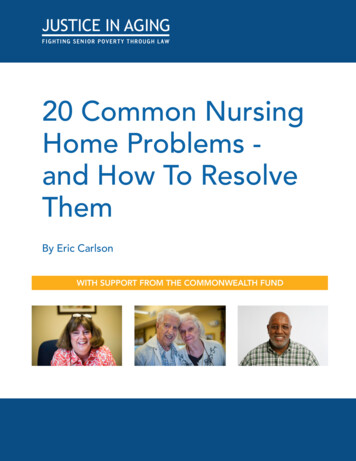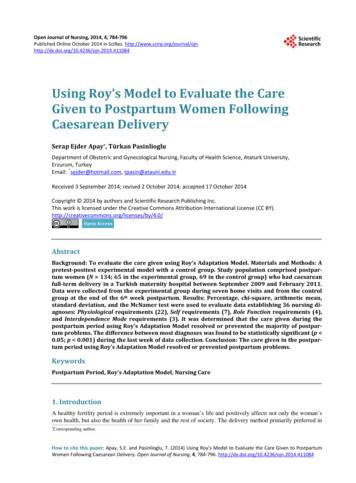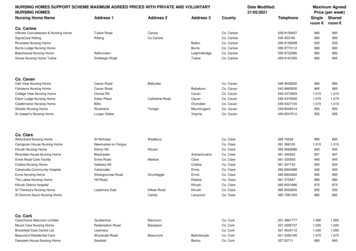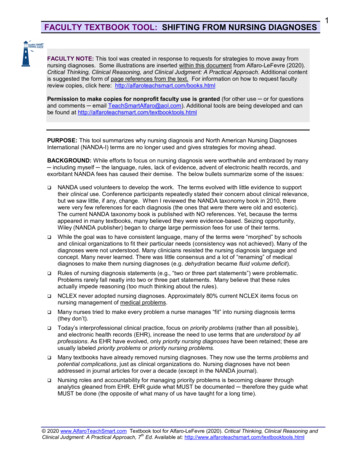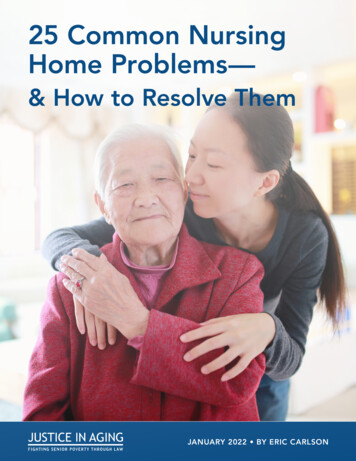
Transcription
25 Common NursingHome Problems—& How to Resolve ThemJANUARY 2022 BY ERIC CARLSON
Introduc tionUSING THIS GUIDEBeware: these 25 problems occur across the country. They happen in cities, suburbs, and ruralcommunities. They also happen both in “good” and “bad” nursing homes. Even the better nursinghomes tend to follow standard procedures that violate federal law and harm residents.The best way to receive high quality care is to settle for nothing else, each and every day. Thisguide gives you the tools to do exactly that.This guide is an updated and expanded version of 20 Common Nursing Home Problems – andHow to Resolve Them, which was written with financial support from the Commonwealth Fund. Thisrevision, like the original edition, introduces each common problem by identifying a false statementcommonly made by nursing home staff, along with a clear statement of the relevant law.This new edition addresses additional problems, discusses issues in more detail, and includesrecent revisions to federal regulations and guidance. This edition emphasizes strategies to preventevictions, as described in the discussion of Problems #7 through #14.Whether you are a nursing home resident, a family member, or a supportive friend, this guidegives you the tools you need to identify and then resolve the problems that residents mostfrequently face. Your determined advocacy can be the difference between going-through-themotions nursing home care, and the high quality, person-centered care that residents are promisedby federal law.THE NURSING HOME REFORM LAWFederal nursing home law applies across the country, and is called the Nursing Home ReformLaw.1 The Reform Law applies to every nursing home that is certified to accept payment from theMedicare or Medicaid programs (or both), even if the resident involved is not utilizing Medicare orMedicaid payment. Because Medicare and Medicaid are important sources of payment, almost allnursing homes are governed by the Reform Law. Information on Medicare or Medicaid certificationfor a particular nursing home is available on the federal government’s Care Compare website.2The Reform Law's cornerstone is the requirement that each nursing home provide the careneeded by a resident to reach the highest practicable level of functioning.3 Some residents arecapable of gaining strength and function; other residents are capable of maintaining their currentcondition. Still other residents, at most, may be able to moderate their level of decline. In each ofthese situations, the nursing home must provide all necessary and appropriate care.The Reform Law’s regulations are found in Title 42 of the Code of Federal Regulations, fromsections 483.1 through 483.95. Guidance to government surveyors on how to interpret and applythese regulations is compiled in Surveyor’s Guidelines at Appendix PP to the State OperationsManual of the Centers for Medicare & Medicaid Services (CMS). To find this manual, search theJUSTICE IN AGING 25 Common Nursing Home Problems—& How to Resolve Them 2
Internet for “CMS Manuals” and choose “Internet-Only Manuals” as your starting place. The StateOperations Manual is listed as CMS Publication #100-07.WHERE TO GO FOR HELPIn implementing this guide’s strategies, a resident or resident’s family member at times maybenefit from the assistance of an attorney or other advocate. One good source of help can bethe long-term care ombudsman program. Each state has an ombudsman program that providesadvocacy for nursing home residents without charge. Contact information for a particular state’sombudsman program can be found at the website of the National Long-Term Care OmbudsmanResource Center.4Each state maintains an inspection agency (often part of the state’s Health Department) thatmonitors nursing homes’ compliance with the Reform Law, certifies nursing homes for participationin Medicare and Medicaid, and issues state licenses. Each of these agencies will investigate aconsumer complaint, and can issue warnings or impose penalties to force a nursing home to fix aparticular violation.The National Consumer Voice for Quality Long-Term Care website has many helpful publicationsfor nursing home residents and their families. The federal government’s Care Compare websiteprovides extensive information on individual nursing homes.IMPORTANT NOTEThis guide cannot substitute for the individualized assistance of an attorney or other relevantprofessional. If you require legal or other expert advice, please speak with a competent professionalin your area.JUSTICE IN AGING 25 Common Nursing Home Problems—& How to Resolve Them 3
Table of ContentsPROBLEMS WITH POOR CARE1: Providing Less Care to Medicaid-Eligible Residents102: Failing to Take Care Planning Seriously113: Disregarding Resident Preferences134: Failing to Provide Necessary Services145: Improper Use of Physical Restraints156: Improper Use of Behavior-Modifying Drugs17PROBLEMS WITH EVICTIONS7: Eviction Without Proper Notice198: Eviction for Being ‘Difficult’219: Eviction for Complaining2310: Eviction for Refusing Medical Treatment2411: Eviction for Nonpayment While Medicaid Application Is In Process2512: Eviction Because Medicare Payment Has Ended2613: Eviction to an Unsafe Setting2714: Eviction While Resident Is Hospitalized28MEDICAID CERTIFICATION PROBLEMS3015: Refusal to Accept MedicaidMEDICARE-RELATED PROBLEMS16: Refusal to Bill Medicare3217: Refusal to Pay by Medicare Advantage Plan3418: Losing Therapy for Supposed Failure to Make Progress36JUSTICE IN AGING 25 Common Nursing Home Problems—& How to Resolve Them 4
19: Losing Therapy After Medicare Payment Has Ended3820: Forced Transfer from ‘Medicare Bed’39DENIALS OF RESIDENT RIGHTS21: Imposing Visiting Hours on Families and Friends4122: Refusal to Support Resident and Family Councils43ADMISSION AND BILLING PROBLEMS23: Forcing Family Members and Friends to Take on Financial Liability4424: Forcing Residents to Arbitrate Disputes4625: Excessive Charges48CONCLUDING THOUGHTS49ENDNOTES50JUSTICE IN AGING 25 Common Nursing Home Problems—& How to Resolve Them 5
Recommendation: Speak Up!Can it really be possible that many nursing homes follow unlawful procedures? Regrettably, theanswer is an emphatic “yes,” based on the author’s experiences over more than 25 years.The next question is “How?” How can it be that so many nursing homes routinely violate theNursing Home Reform Law?Certainly part of the answer is consumers’ unfamiliarity with nursing homes and the Reform Law’sprotections. Another part is the unwillingness of residents and family members to complain, due toshyness and a fear that a nursing home will retaliate. Together, this lack of knowledge, shyness, andfear of retaliation allow some nursing homes to develop and follow unlawful procedures.This timidity can harm residents. Residents and families must understand and believe that theresident deserves high-quality nursing home care. A nursing home receives thousands of dollarsmonthly to care for a resident, and is required by the Reform Law to provide individualized care.Residents shouldn’t feel sheepish to ask (for example) for necessary physical therapy, or to beallowed to sleep as long as they want.Federal law prohibits a nursing home from retaliating against someone for making a complaint.5In any case, risk of retaliation is relatively small compared to the risk of being passive. Nursing homeemployees generally have no reason or inclination to retaliate. Complaints usually are made to anursing home’s administrators and nurses, but it is the nurse aides that provide most of the dayto-day care. In any case, the issues covered in this guide are, in most instances, focused on nursinghome policy and not directed against a particular employee.As the cliché counsels, the squeaky wheel gets the grease. If a resident and family are too afraidor shy to ask for anything, the resident almost assuredly will be overlooked. On the other hand,if a resident and family are determined (but generally polite) in asking for individualized care, theresident likely will receive more attention and better care.A Brief Introduction to Medicare,Medicaid & Medicare AdvantageELIGIBILITYUnder both the Medicare and Medicaid programs, an adult beneficiary generally must beat least 65 years old, or disabled, to be eligible. But the programs’ financial requirements differgreatly. Medicare eligibility is based on payroll deductions during the lifetime of the beneficiary orbeneficiary’s spouse. Think of Medicare coverage as a health insurance policy purchased throughpremiums deducted from payroll checks.JUSTICE IN AGING 25 Common Nursing Home Problems—& How to Resolve Them 6
By contrast, financial eligibility under Medicaid is based not on payroll deductions but instead onneed: a beneficiary must have limited resources and income. Think of the Medicaid program as asafety-net health care program for persons who otherwise cannot afford health care. Medicaid rulesvary somewhat from state to state, since the program uses both federal and state funding.The Medicare Advantage program is an alternate way for a Medicare beneficiary to receiveMedicare benefits. Under Medicare Advantage, a managed care plan authorizes and coordinatesthe beneficiary’s Medicare benefits. In general, all of the beneficiary’s Medicare-funded servicesmust be provided by health care providers from the plan’s network.Medicare Advantage is voluntary—the beneficiary chooses whether to convert the traditionalMedicare coverage to the Medicare Advantage managed care model. The Medicare Advantageplan must offer at least the same level of benefits offered by Medicare, and generally promisesadditional benefits and/or reduced cost sharing as an incentive to join.Why do beneficiaries choose to convert Medicare coverage to Medicare Advantage? Theprincipal reasons are the increased benefits and reduced cost sharing mentioned above, alongwith the potential of better care coordination. On the other hand, a Medicare Advantage membergenerally can receive services only from providers in the plan’s network. Also, because a MedicareAdvantage plan receives a fixed monthly per-member payment from Medicare, the plan may have afinancial incentive to reduce expenses by denying requested services.PAYMENT FOR NURSING HOME CAREThe Medicare and Medicaid programs differ in how they pay for nursing home care. Because theMedicaid program is (as described above) a safety-net program for persons who otherwise cannotafford health care, Medicaid can pay indefinitely for nursing home care, assuming that the residentremains financially eligible and continues to need nursing home care.Under Medicaid, the resident might have to pay a monthly deductible, depending on theresident’s income and (in some cases) the income of the resident’s spouse. The name of thismonthly deductible varies from state to state—for example, “patient pay amount,” “share of cost,”or “Medicaid co-payment.” This guide uses the term “patient pay amount.”The Medicare program, by contrast, pays for nursing home care for only a limited period oftime. At most, Medicare can pay for only 100 days of nursing home care per benefit period. A newbenefit period starts when the Medicare beneficiary has not received Medicare-covered inpatientcare in a nursing home or hospital for at least 60 days. (Note: During the ongoing COVID-19emergency period, a new benefit period can start immediately after the preceding benefit period,if the emergency is preventing the benefit period from being restarted.)Of those 100 days, only the first 20 days are paid in full. For days 21 through 100, the beneficiarymust pay a daily co-payment of 194.50 (for 2022). Many Medicare Supplement insurance policies(commonly called “Medigap” policies) will cover this co-payment.The Medicare program can pay for nursing home care only if the resident enters the nursinghome within 30 days after a hospital stay of at least three nights. The need for nursing home caremust be related to the medical care received in the hospital. (Note: The three-night requirementJUSTICE IN AGING 25 Common Nursing Home Problems—& How to Resolve Them 7
is waived during the ongoing COVID-19 emergency period, in order to reduce any incentive that aperson stay in a hospital longer than necessary.)Finally—and this is the biggest limitation of all—Medicare payment for nursing home care isonly available if the resident requires skilled nursing services or skilled rehabilitation services on adaily or almost-daily basis. The need for these skilled services is discussed in detail in this guide’sdiscussions of Problems #16 through #20. Because of this skilled care requirement, the averageMedicare-funded stay in a nursing home lasts less than 30 days.Medicare Advantage coverage generally is similar but not identical to coverage provided bytraditional Medicare. To incentivize enrollment, the plan likely will offer more than 100 days ofcoverage per benefit period, and reduce or eliminate co-payments. Other requirements, however,are more likely to be identical to the standards followed in traditional Medicare—for example,a required three-night hospital stay, or a resident’s need for skilled nursing services or skilledrehabilitation services.COMPARING COVER AGEMEDICAIDMEDICAREo Pays as long as resident needs nursinghome care and remains financially eligible.o Must follow acute-care hospitalizationof at least three nights (waived duringcurrent COVID-19 emergency period).o Resident’s financial obligation, if any,based on income.o Resident must need skilled rehabilitationservices or skilled nursing services.o No more than 100 days, with no morethan 20 days paid in full.o Daily co-payment of 194.50 for day 21and beyond (in 2022; generally increaseseach year).JUSTICE IN AGING 25 Common Nursing Home Problems—& How to Resolve Them 8
A Brief Introduction to theNursing Home Grievance ProcessEach nursing home must have a Grievance Official to accept, investigate, and respond togrievances. Grievances can be made orally or in writing, but the nursing home’s response must bein writing.The nursing home’s written response must include all of the following:1. The date the grievance was received;2. A summary of the grievance;3. Steps taken to investigate the grievance;4. A summary of the nursing home’s conclusions following the investigation;5. A statement as to whether the grievance was confirmed or not;6. Any corrective action taken by the nursing home; and7. The date of the written response.Each nursing home is required to post information on the nursing home’s grievance procedures,along with contact information for the Grievance Official. Upon request, a nursing home mustprovide a resident or resident representative with a copy of the nursing home’s grievance policy.JUSTICE IN AGING 25 Common Nursing Home Problems—& How to Resolve Them 9
POOR CAREProblem #1: Providing Less Care to Medicaid-Eligible ResidentsWHAT YOU HEAR:THE FACTS:“MEDICAID DOES NOTPAY FOR ONE-ONONE ATTENTION.”A MEDICAID-ELIGIBLE RESIDENTIS ENTITLED TO THE SAME LEVELOF SERVICE PROVIDED TO ANYOTHER RESIDENT.Nursing homes often claim that certain types of care are not covered under Medicaid. Staff mayclaim (for example) that a Medicaid-eligible resident cannot receive physical therapy, one-on-oneattention, or hands-on assistance with eating.All such claims are wrong: the Nursing Home Reform Law prohibits a nursing home fromrestricting services based on Medicaid eligibility. A nursing home “must establish and maintainidentical policies and practices regarding transfer, discharge, and the provision of services underthe State [Medicaid] plan for all residents regardless of payment source.”6HOW TO PROTECT MEDICAID-ELIGIBLE RESIDENTSA Medicaid-eligible resident should resist any attempt by the nursing home to give secondclass treatment. Emphasize the federal law (quoted above) that prohibits a nursing home fromdiscriminating against Medicaid-eligible residents.Nursing home staff members are quick to claim—generally without proof—that the nursinghome loses money on each Medicaid-eligible resident. Residents should push back hard againstany arguments based on a nursing home’s supposedly limited finances. What would you think if adoctor, lawyer, or contractor blamed poor performance on a supposedly inadequate rate of pay?You would reject such excuses, and demand that the work be done well. The same should be truewhen dealing with a nursing home.Or consider promises made by nursing homes. When applying for Medicaid certification, anursing home promises federal and state governments that it will provide Medicaid-eligibleresidents with the care guaranteed by the Nursing Home Reform Law. The nursing home can’t haveit both ways: it is completely unfair for a nursing home to accept Medicaid money for a resident’scare, and then turn around and tell the resident that care will be substandard because the nursinghome believes that Medicaid payment rates are too low.If a nursing home feels that Medicaid rates truly are too low, it should withdraw from Medicaid.But as long as the nursing home continues to bill Medicaid, it must provide Medicaid-eligibleresidents with the high-quality care the Reform Law requires.JUSTICE IN AGING 25 Common Nursing Home Problems—& How to Resolve Them 10
A resident or resident’s representative can raise these concerns with the nurses and nurse aidesthat assist the resident. In addition, the resident or representative can file a grievance with thenursing home’s Grievance Official (see page 9).Problem #2: Failing to Take Care Planning SeriouslyWHAT YOU HEAR:THE FACTS:“THE NURSING STAFF WILLDETERMINE THE CARETHAT YOU RECEIVE.”THE RESIDENT AND RESIDENT’SFAMILY CAN PARTICIPATE INDEVELOPING A CARE PLAN.A nursing home must prepare a full written assessment of a resident’s condition within 14 daysafter admission, and thereafter at least once every 12 months and after a significant change in theresident’s condition. More limited assessments must be done at least once every three months.Assessments use a standardized document called the Minimum Data Set (“MDS”). Full assessmentsinclude dozens of items related to the resident’s condition, including the ability to perform activitiesof daily living, preferences for daily routines, health care needs, and interest in moving out of thenursing home.These assessments are used to develop a comprehensive care plan, which must be preparedinitially within seven days after completion of the first full assessment. Every three months, careplans must be reviewed and, if necessary, revised. Also, a care plan can be reviewed and revised atany time as necessary.The care plan is prepared by a team that includes the resident’s doctor, a registered nurse,a nurse aide who works with the resident, and other appropriate nursing home staff members.Most importantly, the team should include the resident, the resident’s legal representative, and/or a member of the resident’s family.7 The care plan must be “person-centered” so that theresident can make choices and have control over their life. Under federal Surveyor’s Guidelines,the nursing home staff must take steps to facilitate family participation, including scheduling careplanning meetings at workable times for family members, or setting up conference calls or videoconferencing.HOW TO ENSURE A GOOD CARE PLANThe resident and family member should attend all care plan meetings. (In this discussion, “familymember” includes the resident’s legal representative.) If the nursing home fails to give notice ofthe meetings, the resident or family member should ask when the meetings are being held, andrequest to be included.Take care planning seriously. An individualized care plan can be invaluable in improving aresident’s life.JUSTICE IN AGING 25 Common Nursing Home Problems—& How to Resolve Them 11
Prior to a care plan meeting, the resident or family member should think creatively about whatthe resident might want or appreciate. Don’t be timid. A nursing home receives thousands ofdollars monthly to care for a resident, and is required by the Reform Law to address a resident’sspecific needs and preferences (see “Disregarding Resident Preferences” for more information onresident preferences).Some nursing homes treat care plans as a meaningless formality, resulting in care plans that areheavily repetitive from one resident to another. Such drowsy care planning can harm residents. Tobe meaningful, a care plan truly should address individual residents’ needs and preferences.A resident or family member often feels intimidated by care planning meetings. “Who am I,” afamily member might think, “to tell a nurse what should be done for my dad in a nursing home?”This sense of intimidation or shyness is only intensified by the fact that, in a care plan meeting, aresident or family member is likely outnumbered by nursing home staff members.Resist any sense of intimidation. Actually, most care planning decisions do not involvecomplicated medical issues. Instead, the optimal plan of care is relatively obvious; the main issue iswhether the nursing home will commit to providing that type of care.So, the resident or family member should not feel limited to a one-size-fits-all care planpresented by the nursing home. The resident or family member should think of what the residentneeds or prefers, and ask that it be written into the care plan.Once the care plan is in place, the resident or family member can use it as needed to ensure thatthe resident receives the best possible care. Assume for example that the care plan calls for theresident to walk around the block daily, with assistance, but the nursing home fails to make a staffmember available to assist the resident. In addressing this problem, the resident or family membercan point to the care plan as requiring the nursing home to provide the necessary assistance.What Might a Care Plan Include?Here are some examples:o Assistance with daily activities such as dressing, eating, and using the toileto Assistance with brushing teeth or cleaning dentureso A favorite game or songo Dietary restrictions and preferenceso Need to be repositioned frequently in order to avoid skin breakdownso Exerciseso Interest in visiting a nearby parko Preferred schedule for waking up and going to bedo Preparations for moving out of the nursing homeJUSTICE IN AGING 25 Common Nursing Home Problems—& How to Resolve Them 12
Problem #3: Disregarding Resident PreferencesWHAT YOU HEAR:THE FACTS:“WE DON’T HAVEENOUGH STAFF TOACCOMMODATEINDIVIDUAL SCHEDULES.YOU MUST WAKE UP AT 6A.M. EVERY MORNING.”A NURSING HOME MUST MAKEREASONABLE ADJUSTMENTS TOHONOR A RESIDENT’S NEEDSAND PREFERENCES.“OUR GROUP ACTIVITYALWAYS IS BINGO.”“IF YOU DON’T LIKE THEDINNER ENTRÉE, YOURONLY OPTION IS A PEANUTBUTTER SANDWICH.”The ability to make choices is vital to a resident’s quality of life. A nursing home should feel like ahome rather than a health care assembly line.Consistent with these principles, a nursing home must make reasonable adjustments to meetresident needs and preferences. For example, a resident has the “right to choose activities,schedules (including sleeping and waking times), health care, and providers of health care servicesconsistent with his or her interests, assessments, [and] plan of care.”8The resident or resident’s representative should not feel bound by a nursing home’s standardoperating procedures. It does not necessarily matter that the nursing home never has allowedresidents to sleep past 6 a.m., or has refused to serve Chinese food (for example). If a requestedchange in procedure is reasonable, the nursing home must make the change.Of course, the critical question is “What is reasonable?,” but this question has no scientificanswer. Because the definition of “reasonable” is not precise, residents and family membersmust be prepared to explain why the benefit is worth whatever inconvenience or expense may beinvolved.More enlightened nursing homes are realizing the benefits—both to residents and the nursinghomes—of giving more control to residents and individual staff members. The goal: to changenursing home culture so care is more person-centered. By changing the culture, nursing homesJUSTICE IN AGING 25 Common Nursing Home Problems—& How to Resolve Them 13
across the country have improved resident care and customer satisfaction, and have done so whilemaking a profit. The message to nursing homes is: “Good care is good business.”HOW TO PROMOTE RESIDENT CHOICEAgain, a resident or resident’s representative should not hesitate in making requests. The nursinghome receives thousands of dollars for the care of each resident. And money aside, there are legaland moral reasons for treating each and every resident as an individual human being.Letting a resident sleep past 6 a.m. (or 7 a.m. or 8 a.m.) is easily supportable: of course an adultwould not want to be forced awake every single day. The nursing home could adjust its nurse aideschedules and, as necessary, increase nurse aide staffing levels. A very late-waking resident couldbe served cereal and fruit rather than a hot breakfast.In requesting a change, the resident or resident’s representative should explain why the changewould be good for the resident, and why the law requires such a change. A follow-up letter ishelpful, as is a copy of this guide. Oftentimes, the request for a change can be made in a careplanning meeting (see “Failing to Take Care Planning Seriously”). Furthermore, the resident orrepresentative may wish to file a grievance with the nursing home’s Grievance Official (see page9).A resident council or family council (see “Refusal to Support Resident and Family Councils”) canbe a good place in which to organize support for a change in a nursing home’s procedures, andspecifically for more person-centered care. Strength is in numbers: if an entire group of residentsand family members pushes for a particular change, the nursing home is much more likely to seethe light.Problem #4: Failing to Provide Necessary ServicesWHAT YOU HEAR:THE FACTS:“WE DON’T HAVEENOUGH STAFF. YOUSHOULD HIRE YOUR OWNPRIVATE-DUTY AIDE.”A NURSING HOME MUST PROVIDEALL NECESSARY CARE.As previously discussed, the Reform Law’s cornerstone is the requirement that each nursinghome provide the care necessary for a resident to reach the highest practicable level offunctioning.9 A nursing home violates that requirement by expecting or encouraging the hiring ofprivate-duty aides to cover for the nursing home’s inadequacies.JUSTICE IN AGING 25 Common Nursing Home Problems—& How to Resolve Them 14
WHAT TO DO TO ENSURE ALL NECESSARY SERVICES ARE PROVIDEDThe resident or family member should make clear that the nursing home has the legalresponsibility to provide necessary care, and that a claimed shortage of staff or money is no excuse.The specific request should be made in writing to the nursing home’s Grievance Official (see page9); if necessary, the relevant law and/or a copy of this guide can be included as support. The needfor the specific care might be shown by such documents as a doctor’s order, the assessment, and/or the care plan.If the nursing home continues to deny necessary care, a complaint can be made to the stateinspection agency (see “Introduction”). Other options include raising the issue at a resident orfamily council meeting (see “Refusal to Support Resident and Family Councils”), seeking assistancefrom the long-term care ombudsman program (see “Introduction”), or consulting with an attorney.Problem #5: Improper Use of Physical RestraintsWHAT YOU HEAR:THE FACTS:“YOUR FATHER MAY FALLIF WE DON’T TIE HIM INTOA CHAIR. THERE’S JUST NOWAY WE CAN ALWAYS BEWATCHING HIM.”PHYSICAL RESTRAINTS CANNOTBE USED FOR THE NURSINGHOME’S CONVENIENCE.A physical restraint is a device that restricts a resident’s freedom of movement. Perhaps the mostcommon physical restraint is a vest that ties the resident into a wheelchair or bed. A seat belt is aphysical restraint, as is a chair angled back to prevent the resident from standing up. Bed rails alsocan be used as a physical restraint.Under the Nursing Home Reform Law, a physical restraint can be used only to treat a resident’smedical conditions or symptoms. Restraints never can be used for discipline or the nursing home’sconvenience.10 A nursing home must suggest less restrictive methods of managing any problem forwhich restraints are being recommended. An alternative to bed rails, for example, is a bed that canbe lowered to just a few inches from the floor, along with a padded mat placed next to the bed.The use of physical restraints has dropped drastically over the past twenty-five years; manynursing homes now function completely restraint-free. Part of this decline certainly is due to theReform Law, but another part comes from a growing medical consensus that restraints harmresidents. By limiting a resident’s ability to move, restraints may cause a resident to become evermore unsteady, and more susceptible to falls and injuries. Some residents are asphyxiated and dieafter becoming tangled up in restraints. Psychological consequences may also be devastating—understandably, a resident can be frustrated and humiliated by being tied up and unable to move.JUSTICE IN AGING 25 Common Nursing Home Problems—& How to Resolve Them 15
Like any type of medical intervention, physical restraints require the consent of the resident or(if the resident does not have the mental capacity to consent) the resident’s representative. If theresident’s doctor recommends restraints, the resident or resident’s representative decides whetherto accept or reject that recommendation. That choice should be made with knowledge of restraints’potentially negative consequences.HOW TO LIMIT USE OF RESTRAINTSThe most important protection is the rule that restraints require consent. You, the reader, cannotbe restrai
Jan 25, 2019 · The Medicare program, by contrast, pays for nursing home care for only a limited period of time. At most, Medicare can pay for only 100 days of nursing home care per benefit period. A new benefit period starts when the Medicare beneficiary has not received Medicare-covered inpatient care



